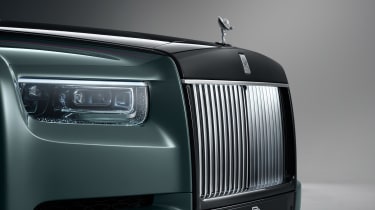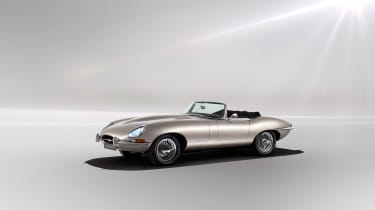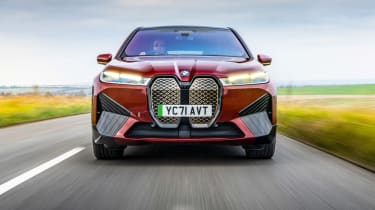How to design a car (part seven): getting air in and out
Cooling engines and now batteries is a crucial element of car design – although sometimes what you see is an identity-providing illusion
The motor car is a complex device that burns stuff to produce energy that then moves it along the road. It could originally burn coal, then petrol or diesel as liquid fuels. With the electric car it often means burning stuff at a distance (what I call the ‘external combustion engine’), the hope being that eventually all electrical energy will come from wind, solar or, more contentiously, nuclear sources. (Nuclear power is, or so we are told, a clean and efficient way of boiling water to make steam, which turns turbines to produce electricity, the initial heat produced by splitting uranium atoms in a process called fission.)
Because of the basic inefficiency of all these methods of having a transportable energy storage system, waste heat is a problem. There used to be a car park at the top of Wrotham Hill on the way from London to Kent where cars could ‘let off steam’ after climbing the 130-metre-high hill. Until I bought an early VW Beetle this almost always happened to me when visiting my grandparents.
The front-end view of an early Edwardian car was dominated by the heat exchanger, possibly wrongly called the radiator. This system passed the heated water from the engine through a maze of copper pipes that had fins laboriously soldered to them. The radiator rapidly became the differentiator between one manufacturer and another. The Rolls-Royce version was simple, elegant and said to be based on the proportions of the Parthenon in Athens. It was not too expensive to make and was easily copied by manufacturers such as Moon in America. Rolls always fought against these infringements of its copyright, most often without too much success.
> How to design a car (part six): electric cars
These front-mounted radiators were fragile and exposed to stones thrown up by cars ahead; they also tended to leak, and when the car overheated, all the cooling water was lost as steam. Before the arrival of water pumps many cars used a system called ‘thermo syphon’ to circulate the water, the idea based on the scientific principal that warm water rises above cold water. This optimistic method of cooling was never a great success but was liked as a way to save money.
The first water pumps tended to leak or needed frequent attention to keep the water inside. The air-cooled car looked like a much better idea but the engine was more costly to produce, and if it was mounted at the front of the car the heated air would roast the occupants in the summer. If mounted at the rear, it was a more complicated and noisy way to warm the passengers in the winter.
By the late 1930s and early 1940s, when all-enveloping monocoque body designs replaced cars with classic exposed radiator shells, many manufacturers struggled to retain their recognisable upright designs. Without the large exposed surface area of the traditional radiator, cooling air had to be encouraged to reach the radiator core to control overheating. Many manufactures did not realise that the air not only needed an efficient way in but also needed an efficient way out, particularly with high-performance sports cars. Anyone who has travelled in an E-type Jaguar in the hot summer months quickly learns that.
In the 1950s and early ’60s, modern cars with simple engine firewalls needed more efficient ways of keeping the car’s occupants comfortable when outside temperatures were high. Little folding quarterlights ahead of the front door glass could be turned around to give a bit of a cooling breeze, but only when the car was moving, and your feet still cooked! This was when the cockpit fan became popular, but it needed a supply of cold air from somewhere other than the engine compartment.
Outside of the USA it was probably the Mk1 Ford Cortina that first attempted to make what they called a ‘flow-through’ interior fresh-air system. Slots in the scuttle panel (a high-pressure area) ahead of the windscreen took outside air, passed it through a fan and then through adjustable air vents on the fascia, and finally out through exit vents into a low-pressure area on the C-pillars. With the later trend of hiding the windscreen wipers in a slot ahead of the windscreen, this slot was also used to take in cooler cockpit air – and leaves in the autumn, and snow in the winter.
Smart as European manufacturers have always considered themselves when laughing at the Americans, the US automobile industry was way ahead when it came to passenger comfort. It is not by chance that the car markets in hot countries such as Australia, Egypt, Iran and India, for example, were dominated by American manufacturers.
Simply put, the only air available to the engineers and designers of an automobile is within the frontal area of the car. If you want more, you have to reach up and grab it with a duct or above-surface mounted intake. The dramatic Lamborghini Countach concept was clearly styled with little thought for cooling air, the arrival of big square boxes above the rear wheels told you that something needed fixing. However, the brilliant oil cooler duct on the underside of the Supermarine Spitfire was so efficient that instead of contributing to the drag of the aircraft it actually produced thrust.
Higher top speeds, lower drag, and brakes hidden within the wheels of performance cars meant that some kind of brake-cooling ducts were needed, particularly on racing sports cars. These ducts became an indicator of sporting potential, but in recent years fake ducts have appeared on everything from SUVs to city cars. Functional air-outlet gills ahead of the doors, as I used on the MG SV in 2002 [see opening image], later appeared on Range Rovers, but those then migrated to the door panels as fake elements of the pressing. What is this fascination with bogus vents? It is the same thing with radiator air intakes: the giant, drooping lower-jaw intakes on Audi and BMW sporting models are so much larger than they need to be that most of the plastic intake holes are blocked off.
McLaren’s range of sports cars are interesting. They are all based around essentially the same carbon monocoque tub and all use the same radiator layout, with cores mounted either side of the tub just behind the doors. But in order to differentiate between the multitude of models, the intakes come in a number of shapes, sizes or locations. This is either very clever or, in some cases, very inefficient, but it is indicative of how difficult it is for a low-volume manufacturer to avoid huge investment costs for unseen components.
Electric vehicles are no different from ICE models: they need both cooling and temperature control of their sensitive electrical components, just not in conventional places. The multitude of cells inside what is referred to as the ‘battery’ all need to be kept at the same temperature, and as when Goldilocks was tasting the three bears’ porridge, they must be ‘not too hot, not too cold, but just right’.
The disappearance of the need for the traditional front-end graphic identifier for electric cars seems to have caused consternation among many manufacturers. Some just fake it with a black plastic moulding that pretends to be what it clearly is not (Audi, Jaguar and BMW). Some pay lip-service to their remembered past with a vague body-coloured outline of a radiator intake (Ford Mustang Mach-E). Some have a thin, minimalist reference to a grille opening (Kia EV6 and Renault Zoe). And some just let you know that a new technology hides within the car without any fakery (Hyundai Kona Electric).
The possibility here is that many manufacturers are not confident in understanding what their customers will accept. In the past, car companies that made rear-engined cars, such as Renault, Porsche, Skoda, Tatra and even Chevrolet (with its Corvair), were sufficiently confident in the credibility of their engineering that they didn’t need to suggest that the car was something other than what it was. That confidence may eventually come back.
This is part seven of our series 'How to design a car with Peter Stevens', first published in evo 297. For the latest issue, subscriptions, or to purchase any back issues, visit our new online store here!







